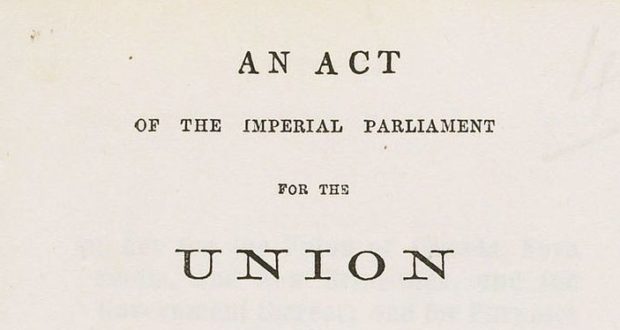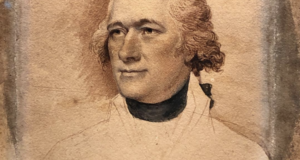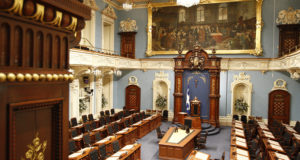Justice Côté’s partial dissenting reasons in References re Greenhouse Gas Pollution Pricing Act, 2021 SCC 11 offered an original interpretation of the Constitution Act, 1867 that challenges the conventional view on the Parliament of Canada’s authority to enact Henry VIII clauses. A Henry VIII clause is a statutory provision that delegates to the executive the power to amended an enabling statute.[1] Justice Côté would have held that two provisions of the Constitution Act, 1867, ss. 17 and 91, constrain how the Parliament may exercise legislative power by requiring that “every exercise of legislative power must have the consent of all three elements of Parliament: the Queen, the Senate and the House of Commons.”[2] As a result, she found that “clauses that purport to confer on the executive branch the power to nullify or amend Acts of Parliament are unconstitutional.”[3] Although her decision is not without its (learned) critics, in my view, she got it right.
In this post, I explore important philosophic and historical interpretive contexts which, although unmentioned by Justice Côté, support her particular use of the unwritten constitutional principles and her ultimate conclusion that Henry VIII clauses are unconstitutional. As I explain below, examining the philosophic and historical context in which the Constitution Act, 1867 was enacted, including, ss. 17 and 91, leads to the conclusion that our Constitution is structured to protect individual liberty through a scheme of mixed government and a balanced separation of powers. And, just as Parliament cannot transfer law-making authority from one order of government to another so as to alter the scheme of the division of powers in ss. 91-95, neither can it transfer its law-making authority to the executive branch so as to alter the scheme of mixed government enacted in the Constitution Act, 1867.
But first I shall address some preliminary questions of methodology. The legal question explored in this post is one of constitutional interpretation. It must, therefore, be answered in accordance with the techniques of constitutional interpretation. In this inquiry, prior authority is of no assistance except in so far as it illuminates, through proper judicial technique, the true meaning of ss. 17 and 91. The Supreme Court’s decision in Re George Edwin Gray is, indeed, authority contrary to my view.[4] However, that fact alone is no answer to the question at hand. That is an issue of stare decisis – one which I do not propose to resolve here.
Further, my objective here is not to show what ideas were percolating in the particular minds of John A. Macdonald, George-Étienne Carter, or any of the other so-called Fathers of Confederation. Neither do I seek to show what were the subjective intentions of the Framers of the Constitution Act, 1982. My objective, rather, is to understand the text of the Constitution Act, 1867 by placing it within its proper philosophic and historical contexts, as the Supreme Court of Canada’s jurisprudence on constitutional interpretation requires.[5]
I offer one final caveat before joining the fray. By drawing on a particular philosophical tradition and set of historical events for this post, I do not mean to suggest that these are the only sets of ideas, events, and contexts which are relevant to understanding the Constitution. My point is simply that these particular philosophic and historical contexts are especially relevant to understanding the meaning of ss. 17 and 91. For example, I will suggest below that Toryism, as a set of political beliefs and values, declined in popularity by 1867, but I would not write the theory of a “Tory Touch” out of Canadian political or constitutional history and it may carry some interpretative weight where relevant.[6]
Philosophic Context: Two Conceptions of Liberty
The idea of liberty, as it was understood in the mid-19th Century, can be divided into two distinct conceptions. I shall style the first conception “ancient liberty” and the second conception “modern liberty”. It would take a great many words to give these two sets of ideas their full due, but for the purposes of this article I will provide only a brief description and comparison.[7]
In a nutshell, ancient liberty is centered on the rights of “the People” to participate in, and to control, the political process, whereas modern liberty focuses on protecting the rights of the individual. Ancient liberty was the philosophy of Thomas Paine, Thomas Jefferson, Jean Jacques Rousseau, and Maximillian Robespierre. Modern liberty was the philosophy of John Locke, William Blackstone, Edmund Burke, and Alexander Hamilton.
Owing to its emphasis on political participation by the People, ancient liberty locates sovereignty in the legislative branch, from which the powers of all other branches must flow. In contrast, modern liberty strives for a balance between the powers of the legislative, executive, and judicial branches to prevent a concentration of power. Modern liberty, nonetheless, locates sovereignty within the institution of Parliament. But this is so because Parliament itself is based on an internal division of powers comprised of the monarchic, aristocratic, and democratic elements of society. In the British Parliament, these elements are represented by the Crown, the House of Lords, and the House of Commons. Under the modern conception of liberty, therefore, Parliament is sovereign, not because it is democratic, but because it represents the three elements, of which only one is democratic. A state based on modern liberty, therefore, is “organized around a balance of power and forces within the sovereign power: a mixed government.”[8]
A state founded on the basis of ancient liberty does not place any constraints on the legislative power, because the General Will of the People – as expressed in legislation – is regarded as the font of all authority. However, a state founded on modern liberty requires at least some constraints on the legislative power.[9] As it is the institution of Parliament that is entrusted with the sovereign law-making authority, Parliament “cannot transfer the power of making laws to any other hands” as its power is “only to make laws, and not to make legislators”.[10] If Parliament were able to delegate its law-making authority, it would disrupt the balance of powers and the scheme of mixed government by concentrating power in the federal executive branch and in the monarchic element, to the detriment of individual liberty.
I will discuss modern liberty’s implications for Henry VIII clauses further below, after explaining why it is that the text of the Constitution Act, 1867 should be interpreted with modern liberty in mind.
Historical Context: The Triumph of Modern Liberty in British North America before 1867
Two critical historical developments loomed large in the living memory of the generation that assented to the union of the colonies of British North America in 1867: (1) the political agitation culminating in the uprisings in Upper and Lower Canada in 1837-1838; and (2) the struggle for responsible government and the upheavals surrounding the adoption of the Rebellion Loses Bill in 1849. These two historical episodes marked the unabashed triumph of modern liberty in the public consciousness of British North America. Modern liberty had become the dominant political ideology of the day by 1867 and would have loomed large in the mind of an ordinary member of the public trying to understand the text of the Constitution Act, 1867 at the time of its enactment.
In The Idea of Liberty in Canada during the Age of Atlantic Revolutions, Professor Michel Ducharme tells the story of a competition between ancient and modern liberty in the public consciousness of Upper and Lower Canada from 1776 to 1838. In short, modern liberty was prominent in the public discourse at first, but waned as colonial reformers chafed under the obstinate rule of the arch-Tory Family Compact and Chateau Clique. The colonial reform movement skewed radical from the 1820s onward, with ancient liberty serving as its rallying cry. But, the radical reformers’ defeat on the battlefields of 1837 and 1838 was also a resounding defeat for ancient liberty as a political force in British North America. Thereafter, ancient liberty was seen as the gospel of a dangerous and subversive element and the moderate reformers rallied around the banner of modern liberty.
The moderate reformers still had to contend with Toryism as a political force in the colonies, which had also triumphed in the wake of the failed rebellions. In Seven Absolute Rights: Recovering the Historical Foundations of Canada’s Rule of Law, Professor Ryan Alford recounts the rise of the moderate reform movement in the United Province of Canada after 1840 as part of his larger narrative that resituates British constitutional history within Canada’s constitutional history. He notes that the moderate reform movement, headed by Robert Baldwin and Louis-Hippolyte Lafontaine, was a political coalition held together by Whig Constitutionalist views.[11] Baldwin and Lafontaine, of course, spearheaded the successful campaign for Responsible Government.
In 1849, their Great Ministry was put to the test during the turmoil surrounding the passage of the Rebellion Losses Bill. In his assessment, Professor Alford finds that the reformers’ speeches made in support of the bill revealed that “the Baldwin-Lafontaine government’s vision of the constitution was grounded in the seventeenth century consensus on the substantive principles of the rule of law.”[12] It should not be controversial to suppose that this vision of the constitution was also grounded in modern liberty, given the closeness of these concepts – although I admit that Professor Alford does not expressly discuss the history on this basis.[13] The Assembly passed the bill and the Governor General gave it royal assent, prompting a disturbing episode of Tory-fueled political violence, which included the stoning of the Governor General’s carriage and the burning of the legislative building in Montreal.
In the aftermath of the 1849 riots, the old Toryism of the Family Compact and the Chateau Clique was discredited as a political force. As Professor Alford recounts, “a new consensus” was formed thereafter, as the Tories came to adopt the moderate reformers’ view of the constitution.[14] On my reading, this new political consensus was grounded squarely in modern liberty, which, in the words of Professor Ducharme, “constitutes the organizing principle of Canada’s intellectual and political history” and “forms the basis for the modern Canadian state.”[15]
The Constitution Act, 1867 and Modern Liberty
On my reading, the Constitution Act, 1867 enacted a Constitution designed to protect modern liberty, including a balanced separation of powers and a scheme of mixed government.
Justice Côté’s reasons provide a thorough examination of the “architecture” of the Constitution, and I will not needlessly repeat that which has already been excellently stated previously.[16] Briefly, she observes that the Constitution Act, 1867 divides power between three separate branches of government as well as between the two orders of government (i.e. federal and provincial). She then finds that ss. 17 and 91 confer an exclusive function to exercise federal legislative power on the Parliament of Canada. From this, she concludes that Constitution does not permit any other branch (or order for that matter) of government to exercise federal legislative power.
But, what Justice Côté does not discuss, is that the Constitution Act, 1867 not only divides power between separate branches of government, but also provides for a regime of mixed government within the Parliament of Canada itself. The principle of mixed government is unmistakably evident in s. 17, which provides that the Parliament of Canada shall consist of “the Queen, an Upper House styled the Senate, and the House of Commons.” The Queen, obviously, embodies the monarchic element, and the House of Commons embodies the democratic element.
The Senate appears to embody a Canadian adaptation of the aristocratic element,[17] which merits closer examination. Section 22 of the Constitution Act, 1867, divides Senate seats equally between Canada’s historic regions. Section 25 requires that Senators be at least 30 years of age, have a net worth of $4,000 or more, own land within the province of their appointment, and that they reside in that province. It would therefore appear that Senators are intended to represent the interests of their particular regions and provinces in the Parliament of Canada.[18] The Senate, thus, embodies the aristocratic element, which is linked, in Canada, to regional and provincial interests. I therefore conclude that the Constitution Act, 1867 mandates a scheme of mixed government within the legislative branch of the federal government.
Thus, the Constitution Act, 1867 created a constitution of modern liberty for Canada. Under such a scheme, as I explained above, Parliament is sovereign because it is based on an internal division of power between disparate elements, which combined represent the varied interests of the entire nation. And, what is more, the sovereignty of such a Parliament is not unbridled or unrestrained, because it has for its foundation a conception of liberty which is diametrically opposed to the Rousseauian notion that the General Will of the People knows no restraints on its authority. Thus, the power “to make Laws for the Peace, Order, and good Government of Canada” in s. 91 confers upon the Parliament of Canada the power “only to make laws, and not to make legislators”.[19] The power given to Parliament by s. 91 does not confer a power to unmake the scheme of mixed government created in s. 17.
In other words, just as Parliament cannot transfer law-making authority from one order of government to another so as to alter the scheme of the division of powers in ss. 91-95,[20] neither can it transfer its law-making authority to the executive branch so as to alter the scheme of mixed government enacted in the Constitution Act, 1867.
One may object that this interpretation creates an asymmetry between the federal and provincial legislative powers. But, if that is so (which seems to be the likely result of the above analysis), it is only because that asymmetry arises from the text of the Constitution itself and the form of government enacted therein. In addition, an asymmetry which takes power away from the executive branch of the central authority is entirely consistent with modern liberty’s concern to avoid an undue concentration of power and the need to maintain a balanced separation of powers.
One may also contend that the Constitution Act, 1867 created, in Canada, a constitution similar in principle to that of the United Kingdom and that the Parliament of that country enjoys an untrammeled authority to enact Henry VIII clauses. Respectfully, however, this objection ignores the single most defining difference between our respective constitutional arrangements. Canada has a written constitution which operates as a constraint on legislative authority. The question then arises, what is the authority of the federal legislative branch? But this only brings us back to the beginning of the interpretive question and no further.
Doubtless there are further objections and qualifiers to explore. As Professor Daly rightly points out, it may prove difficult to articulate a legal test that clearly sets out permissible delegations from impermissible delegations. I look forward to reading further dialogue on point. However, at least for now, this is my view, respectfully stated.
The author obtained appropriate authorizations prior to the publication of this blog post. This blog post solely represents the views of the author and not that of his employer.
Notes
[1] Reference re Greenhouse Gas Pollution Pricing Act, 2021 SCC 11, para 85, per Wagner CJ.
[2] Reference re Greenhouse Gas Pollution Pricing Act, 2021 SCC 11, para 247, per Côté J. (dissenting in part).
[3] Reference re Greenhouse Gas Pollution Pricing Act, 2021 SCC 11, para 294, per Côté J. (dissenting in part).
[4] Re George Edwin Gray, 1918 CanLII 533 (SCC), 57 SCR 150.
[5] Reference re Senate Reform, 2014 SCC 32, [2014] 1 SCR 704, para 25; Hunter v. Southam Inc., [1984] 2 S.C.R. 145, pp. 155-56; R. v. Big M Drug Mart Ltd., [1985] 1 S.C.R. 295, p. 344.
[6] See Glenn D. Joyal, Traditional Canadian Political Culture Adrift in the Era of the Charter, A Thesis Submitted to the Faculty of Graduate Studies in Partial Fulfillment of the Requirements for the Degree of Master of Arts, University of Manitoba (1993).
[7] For this summary, I draw on the work of Professor Michel Ducharme, translated by Peter Feldstein, in The Idea of Liberty in Canada during the Age of Atlantic Revolutions, 1776-1838 (MQUP, 2014), as well as Janet Ajzenstat, The Canadian Founding: John Locke and Parliament (MQUP, 2007).
[8] Ducharme, The Idea of Liberty in Canada, p. 31.
[9] Ajzenstat, The Canadian Founding, p. 59.
[10] John Locke, Second Treatise of Civil Government (1690), para 141.
[11] The Whigs were a loose political coalition that celebrated the British constitutional settlement arising from the Glorious Revolution of 1688-1689 – perhaps the most perfect embodiment of a constitution of modern liberty.
[12] Ryan Alford, Seven Absolute Rights: Recovering the Historical Foundations of Canada’s Rule of Law (MQUP, 2020), p. 158.
[13] See also Peter H. Russel, Constitutional Odyssey: Can Canadians Become a Sovereign People?, 3rd ed (UTP, 2004), p. 12.
[14] Alford, Seven Absolute Rights, p. 163.
[15] Ducharme, The Idea of Liberty in Canada, p. 186.
[16] Reference re Greenhouse Gas Pollution Pricing Act, 2021 SCC 11, paras 243-263, per Côté J. (dissenting in part).
[17] Reference re Senate Reform, 2014 SCC 32, [2014] 1 SCR 704, para 14.
[18] Reference re Senate Reform, 2014 SCC 32, [2014] 1 SCR 704, para 15; Re: Authority of Parliament in relation to the Upper House, [1980] 1 SCR 54 at pp 66-67.
[19] John Locke, Second Treatise of Civil Government (1690), para 141.
[20] Attorney General of Nova Scotia v. Attorney General of Canada, [1951] SCR 31.
 Advocates for the Rule of Law
Advocates for the Rule of Law



